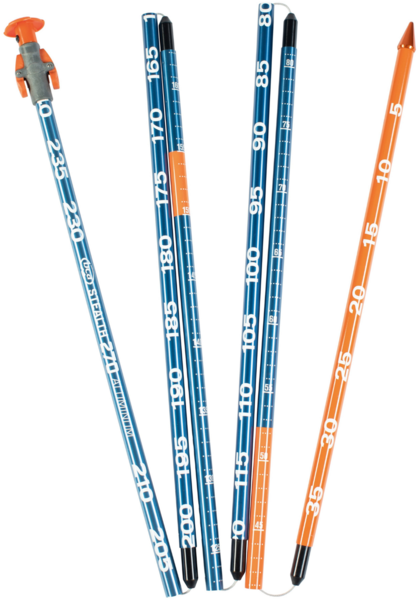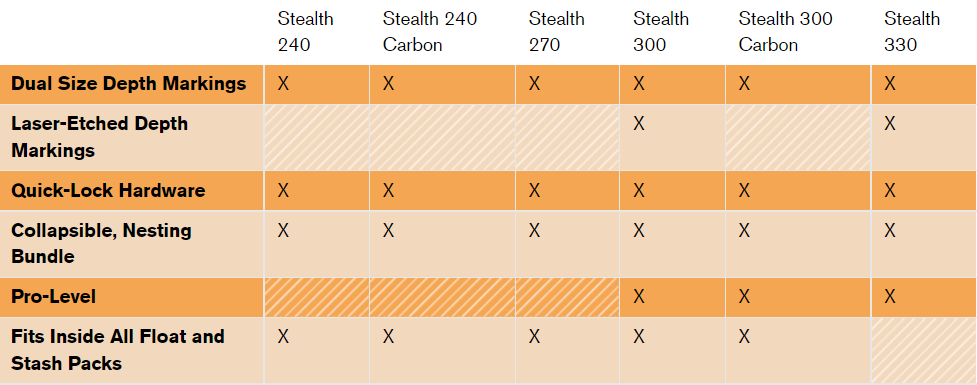Details
The BCA Stealth 270 avalanche probe features the easiest and fastest assembly on the market, with no loose cable to cause hangups.
The top segment stealthfully nests inside the next probe section, reducing the number of segments and size of the probe bundle when disassembled in your pack.
Equipped with laser-etched depth markings for measuring snowpack and/or victim depth to determine the dimensions of the excavation area before shoveling.
BCA Quick-Lock hardware allows for the best packability and deployment speed on the market. Stealth probes are built to last and save valuable seconds during an avalanche rescue when time matters.
| Sku |
C2005009010
|
| Size |
270
|
| Weight | 10.4 oz / 295 g |
| Extended length | 270 cm / 106” |
| Collapsed length | 45 cm / 17.7” |
| Diameter | 1.2 cm / 0.47” |
| Warranty | 3 Year |
FAQS - AVALANCHE PROBES
How do you use an avalanche probe?
BCA recommends that everyone take an avalanche rescue course to learn how to properly use an avalanche probe. You can also watch our Probing 101 video to learn more. https://www.youtube.com/watch?v=-0_yDN5Drzw
What is the difference between an aluminum and a carbon probe?
Carbon probes are lighter than aluminum probes, but aluminum probes are more durable and are more suitable for everyday use.
How do I choose the appropriate probe length?
You should choose your probe length depending on the depth of your snowpack and the intended use. In a shallower Colorado snowpack, a Stealth 240 might be sufficient. If you live in an area with a deeper snowpack or travel to areas that have a deeper snowpack you should consider a longer probe. If your probe is intended for use on organized probe lines, consider a probe at least 300 cm long: this way you won't have to bend over repeatedly as you probe for many hours at a time. It is also important to make sure the collapsed length of your probe will fit inside the pack you are using.
What is the difference between laser-etched and painted depth markings?
The Stealth 300 and 330 aluminum probes have laser-etched depth markings while the carbon probe depth markings are painted on. The laser-etched depth markings are more resistant to wear, for example, if you use your probe and a knotted cord to isolate columns for snow stability tests.
Which BCA packs are the Stealth 240 and Stealth 270 compatible with?
The BCA Stealth 240 and Stealth 270 avalanche probe models are compatible with all BCA Stash backpacks and Float avalanche airbag models.
Which BCA packs are compatible with the Stealth 300 and Stealth 330?
The Stealth 300 and Stealth 330 are compatible with all BCA Stash backpacks and Float avalanche airbags – with a few exceptions. The Stealth 300 and 330 fit in the designated tool compartment of the Float 42, Float 32, Float 22, Float 27 Speed, Float 17 Speed, Float 25 Turbo, Float Turbo 15, and Float MtnPro Vests. They also fit in the Float 12, but only at an angle. BCA suggests that you use either the Stealth 240 or the Stealth 270 for the Float 12 airbag packs.
Which BCA avalanche probes are compatible with the Float MtnPro Avalanche Airbag Vest?
All BCA avalanche probes, including the Stealth 300 and Stealth 330 are compatible with the designated tool compartment inside the main compartment of the Float MtnPro Vest.
Videos
BCA Stealth Probes
Avalanche Probe Resources Probing 101 (Video) - https://www.youtube.com/watch?v=-0_yDN5Drzw FAQs - Avalanche Probes - https://backcountryaccess.com/en-ca/support/faqs-avalanche-probes
Avalanche Rescue Series: Avalanche Probing 101
This updated 101 video takes you through the pinpointing–or probing–stage of an avalanche rescue. BCA's Andy Wenberg illustrates the probing techniques used for companion rescue (when avalanche transceivers are used), spot probing (when no transceivers are used), and probe lines–usually performed by an organized rescue team. This is not a substitute for an avalanche class. Get educated before heading into the winter backcountry. For more educational resources, visit https://backcountryaccess.com/en-us/l...






